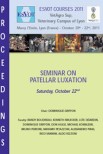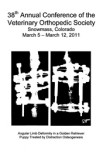OBJECTIVE:
To determine the sensitivity and specificity of the drawer test (DT) alone and in combination with the tibial compression test (TCT) to detect stifle subluxation after transection of the cranial cruciate (CrCL), caudal cruciate (CdCL) or both cruciate ligaments (total cruciate ligament or TCL).
STUDY DESIGN:
Experimental study.
SAMPLE POPULATION:
Cadaveric, skeletally mature canine pelvic limb pairs (n = 8).
METHODS:
Pelvic limbs disarticulated at the coxofemoral joint were randomly assigned to the following 1 of 4 groups: (1) limbs had complete transection of the CrCL; (2) limbs had complete transection of the CdCL; (3) limbs had complete transection of both ligaments; and (4) both ligaments were left intact. Participants performed the DT and the TCT and a diagnosis was given based on the DT and on the combination of these tests.
RESULTS:
DT had a poor sensitivity for correctly identifying CrCL (69%), CdCL (45%), and TCL (26%) rupture, but had a high sensitivity when identifying intact limbs (97%). Specificity for DT was greatest when identifying limbs with CdCL (97%) and TCL (92%) rupture, and the lowest when palpating limbs with CrCL rupture (75%). Combining DT and TCT did not increase sensitivity or specificity values, nor did an increased level of evaluator training.
CONCLUSIONS:
Independent of evaluator training, the DT alone or combined with the TCT poorly differentiates the cause of stifle instability associated with CrCL, CdCL, and TCL rupture.
Evaluation of the drawer test and the tibial compression test for differentiating between cranial and caudal stifle subluxation associated with cruciate ligament instability.
Date
2013 May
Journal
Vet Surg
Volume
42
Number
4
Pages
392-7









